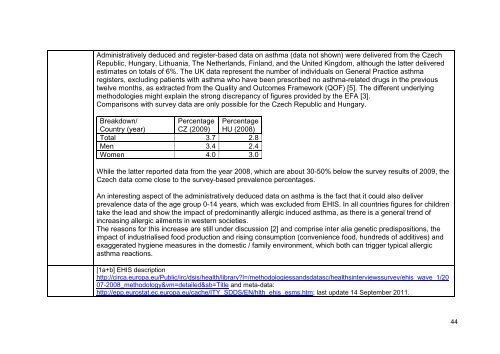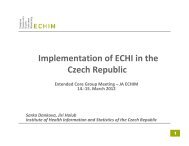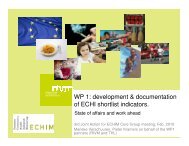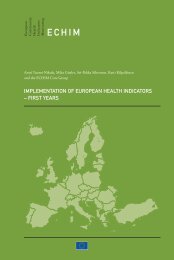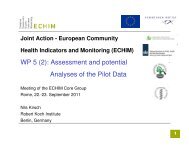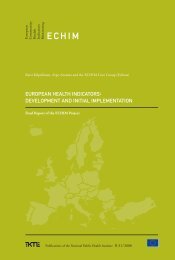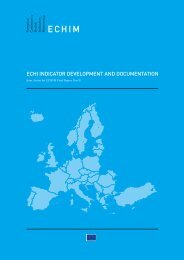Final Report Part III ECHIM Pilot Data Collection Analyses and Dissemination
Part III: ECHIM Pilot Data Collection, Analyses and Dissemination
Part III: ECHIM Pilot Data Collection, Analyses and Dissemination
- No tags were found...
You also want an ePaper? Increase the reach of your titles
YUMPU automatically turns print PDFs into web optimized ePapers that Google loves.
Administratively deduced <strong>and</strong> register-based data on asthma (data not shown) were delivered from the Czech<br />
Republic, Hungary, Lithuania, The Netherl<strong>and</strong>s, Finl<strong>and</strong>, <strong>and</strong> the United Kingdom, although the latter delivered<br />
estimates on totals of 6%. The UK data represent the number of individuals on General Practice asthma<br />
registers, excluding patients with asthma who have been prescribed no asthma-related drugs in the previous<br />
twelve months, as extracted from the Quality <strong>and</strong> Outcomes Framework (QOF) [5]. The different underlying<br />
methodologies might explain the strong discrepancy of figures provided by the EFA [3].<br />
Comparisons with survey data are only possible for the Czech Republic <strong>and</strong> Hungary.<br />
Breakdown/<br />
Country (year)<br />
Percentage<br />
CZ (2009)<br />
Percentage<br />
HU (2008)<br />
Total 3.7 2.8<br />
Men 3.4 2.4<br />
Women 4.0 3.0<br />
While the latter reported data from the year 2008, which are about 30-50% below the survey results of 2009, the<br />
Czech data come close to the survey-based prevalence percentages.<br />
An interesting aspect of the administratively deduced data on asthma is the fact that it could also deliver<br />
prevalence data of the age group 0-14 years, which was excluded from EHIS. In all countries figures for children<br />
take the lead <strong>and</strong> show the impact of predominantly allergic induced asthma, as there is a general trend of<br />
increasing allergic ailments in western societies.<br />
The reasons for this increase are still under discussion [2] <strong>and</strong> comprise inter alia genetic predispositions, the<br />
impact of industrialised food production <strong>and</strong> rising consumption (convenience food, hundreds of additives) <strong>and</strong><br />
exaggerated hygiene measures in the domestic / family environment, which both can trigger typical allergic<br />
asthma reactions.<br />
[1a+b] EHIS description<br />
http://circa.europa.eu/Public/irc/dsis/health/library?l=/methodologiess<strong>and</strong>sdatasc/healthsinterviewssurvey/ehis_wave_1/20<br />
07-2008_methodology&vm=detailed&sb=Title <strong>and</strong> meta-data:<br />
http://epp.eurostat.ec.europa.eu/cache/ITY_SDDS/EN/hlth_ehis_esms.htm; last update 14 September 2011.<br />
44


